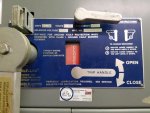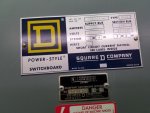xguard
Senior Member
- Location
- Baton Rouge, LA
We have an ATS we are replacing. It wasn't service rated, it's too small, and many other problems. Our service is from a pad mount utility transformer outside the building. The service conductors come underground into the bottom of the switch board. Currently, the service conductors enter the bottom of the switchboard, exit the side of the switchboard, pass through a stairwell (this is another issue) going back outside to an ATS, then re-enter the building back through the stairwell and back through the side of the switchboard finally landing on the switchboard terminals. Whew that was a mouth-full.
If the service conductors were going to another building and passing through this one, this would be a problem (NEC 230.3). But what about going back out a building to an ATS?
Is there another article I'm missing that would not allow us to duplicate this method of entering the switchboard from underground and exiting to the ATS?
If the service conductors were going to another building and passing through this one, this would be a problem (NEC 230.3). But what about going back out a building to an ATS?
Is there another article I'm missing that would not allow us to duplicate this method of entering the switchboard from underground and exiting to the ATS?



